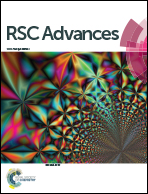Optical-signal-enhancing metasurface platforms for fluorescent molecules at water-transparent near-infrared wavelengths†
Abstract
We report efficient sensing platforms to obtain artificially enhanced optical signals from near-infrared fluorescent molecules with emitting wavelengths in 1.1 μm range, which corresponds to the so-called “living-body window”. Prominent enhancement was experimentally achieved employing high-emittance metasurfaces of plasmo-photonic resonances. In addition, we show that enhanced fluorescence and Raman scattering are selectable using the metasurfaces with and without a self-assembled monolayer, which determines the contact of the molecules with outmost surface of noble metals. We also experimentally studied the effect of Au and Ag on the enhancement of optical signals, and numerically examined the conditions for attaining optimal enhancement. This paper describes a systematic study on artificially enhanced HOMO–LUMO transitions in the fluorescent molecules, explicitly suggesting an effective way to attain prominent enhancement for low-quantum-yield fluorescent molecules.



 Please wait while we load your content...
Please wait while we load your content...